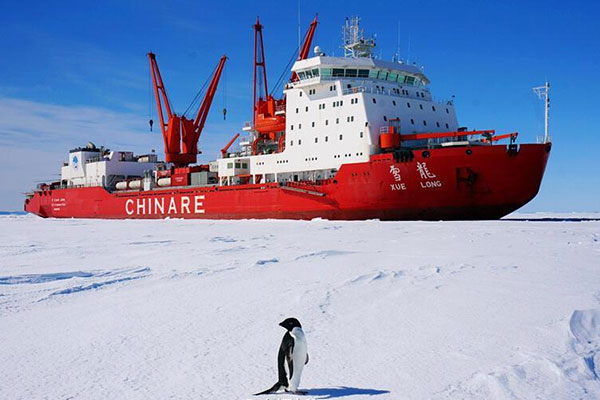
A penguin is seen in front of Chinese icebreaker Xuelong, or Snow Dragon, docked at an ice cover area of the South Pole. The icebreaker is on China's 31st scientific expedition to Antarctica. (Photo from official Weibo of CCTV)
China will set up an Antarctic air squadron this year to support its scientific expeditions to the polar region, according to the State Oceanic Administration.
It did not disclose details about the squadron, but said it is aimed at supporting polar exploration and will serve as an air observation platform.
China will continue to develop technologies and equipment to improve research on remote sensing and oceanography, the administration said in a statement on Friday.
The research vessel and icebreaker Xuelong, which is being used for China's 32nd Antarctic expedition, left Shanghai on Nov 7 for a 159-day round trip of 55,500 kilometers.
A 277-strong team from more than 80 domestic institutions are conducting research and experiments in Antarctica.
During the mission, researchers are making a final survey for China's fifth Antarctic station site at Victoria Land on the Ross Sea, mapping the site and assessing the ecological and environmental impacts.
They will also perform scientific experiments at China's Changcheng, Zhongshan, Taishan and Kunlun stations, as well as at Prydz Bay, on the Ross Sea, on the Amundsen Sea and the Antarctic Peninsula.
For the first time, members of the expedition used a fixed wing aircraft during their stay in the Antarctic.
The plane, which was bought from the United States and is now maintained by a Canadian company, carried out airborne remote sensing and telemetry tasks before leaving for Canada last week. Previously, China had used only helicopters for its polar expeditions.
Sun Bo, deputy head of the Polar Research Institute of China, said the country is training pilots, ground support staff members and scientific instrument operators for fixed-wing polar aircraft so they can operate and manage China's polar aircraft fleet.
Meanwhile, the State Oceanic Administration said it will launch several deep-sea projects this year involving seabed mining experiments, biological diversity research and deep-water exploration.
A deep-sea exploration station is also included in the administration's equipment development plan.
The country will send its seventh research mission to the Arctic this year and is planning the first Sino-Russian Arctic mission, it said.


















































